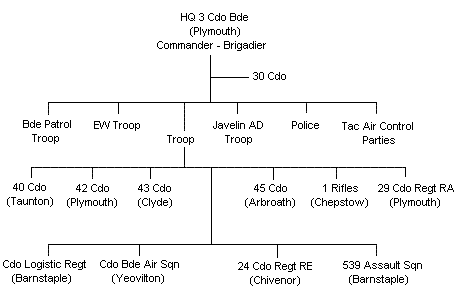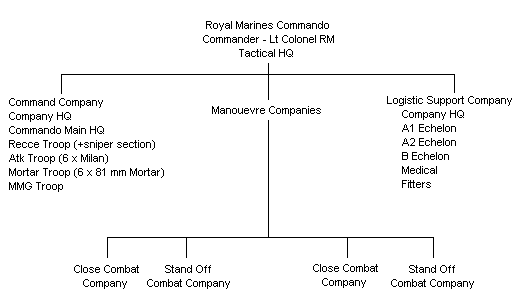|
SUMMARY
The Royal Marines (RM) are an elite
Corps and specialists in Amphibious Warfare - and wherever there is
action, the Royal Marines are likely to be involved. They were prominent, for example, in the Falklands
campaign, and they could be found wherever the UK Armed Services are actively
involved e.g. Northern Ireland, the Balkans, Sierra Leone, Afghanistan and Iraq.
The Royal Marines number approximately 6,850
(including 760 officers) and, since the end of the
Cold War, and especially in recent years, the Corps appears to have
reverted to its traditional role of being ready for operations anywhere in
the world.
All Royal Marines, except those in the Royal Marines Band Service, are
first and foremost, commando soldiers. They are required to undergo what
is recognised as one of the longest and most demanding infantry training
courses in the world. This is undertaken at the Commando Training Centre
Royal Marines at Lympstone in UK’s West Country, not far from Dartmoor.
The titular head of the Royal Marines is always a Major General – Commandant
General Royal Marines (CGRM). There have been significant recent structural
changes in the higher management of the Royal Navy recently and this has added
to the responsibilities and raised the profile of CGRM.
The Royal Marines have small detachments in ships at sea and other units
worldwide with widely differing tasks. However, the bulk of the manpower of the
Royal Marines is grouped in battalion-sized organisations known as Commandos (Cdo).
There are 4 Commando Groups and they are part of a larger formation known as 3
Commando Brigade (3 Cdo Bde).
3 CDO BDE COMMANDO ORGANISATION

(1) For operations expect 3 Commando Brigade to come under the command of
the Joint Forces Command (JFC).
(2) 30 Commando - Information Exploitation Group is the organisation
that provides command, communications, reconnaissance and intelligence
capabilities to 3 Comando Brigade.
(3) 1st Battalion The Rifles – 3 Commando Brigade’s Fourth Manoeuvre
Unit
From 1 April 2008 1 Rifles has been attached to 3 Commando Brigade as a
fourth manoeuvre unit. 3 Commando Brigade is now capable of providing a
both a brigade at high readiness for operations anywhere in the world
and also has the ability to support programmed operations.
1 Rifles will remain on the Army list under the Full Command of the
Chief of the General Staff but serve under the direction of the
Commander in Chief Fleet and the Commander of 3 Commando Brigade Royal
Marines. The battalion has been structured as a Light Role Battalion and
personnel will continue to wear the Rifles cap-badge. For normal
tri-service operations
(4) 539 Assault Squadron has the personnel that allows troops and
equipment from 3 Commando Brigade to land from vessels at sea to the
operational areas (mainly beaches) where operations are to be conducted.
539 Assault Squadron is equipped with hovercraft, landing craft, raiding
craft and Viking vehicles.
(5) 29 Cdo Regt RA has one battery stationed at Arbroath with 45 Cdo.
(7) 1st Bn The Royal Netherlands Marine Corps can be part of 3 Cdo Bde
for NATO assigned tasks.
(8) There are three regular Tactical Air Control Parties and one
reserve.

COMMANDO ORGANISATION

|